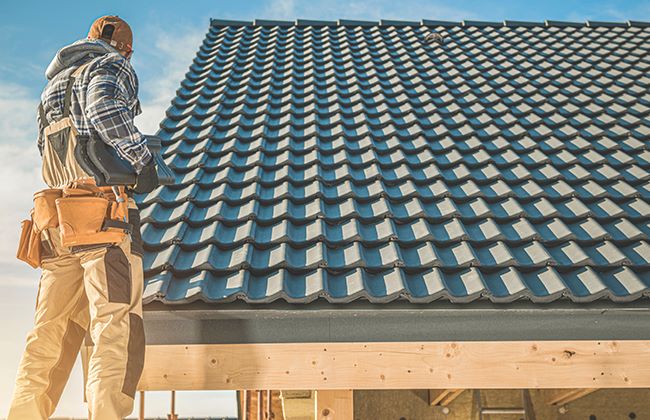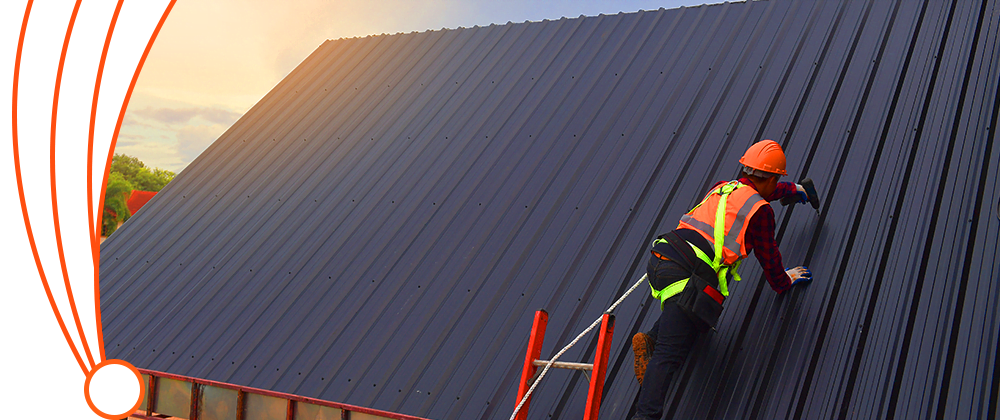When it comes to roof repair, most homeowners don’t know where to start. This guide will walk you through everything you need to know about roof repair, from costs to maintenance. By the end of this guide, you’ll have a comprehensive understanding of all things related to roof repair!
Whether you own your home or are renting, you’ll find valuable insights on maintaining, repairing, and even replacing your roof. Say goodbye to roofing issues once and for all with our detailed guide.
What is Roof Repair and Why Do You Need It?
Roof repair is the process of fixing or replacing a roof that has been damaged. The damage can be caused by weather, age, or other factors. Roof repair can be a simple fix, such as replacing a few shingles, or it can be more complex, such as fixing leaks or repairing structural damage.
Why do you need roof repair? Because a damaged roof can lead to bigger problems, such as water damage to your home or office. If left unrepaired, a damaged roof can also cause health problems for you and your family.
Factors That Affect Roofing Repair Cost
Your roof is one of the most important parts of your house, and it needs to be in good condition to protect your home from the elements. When it comes time to repair your roof, there are a few factors that will affect the cost from which you can understand what is the average roofing repair cost.
- The first factor is the type of roof you have. There are different types of materials used for roofing, and each has its price point. The most common roofing materials are asphalt shingles, metal roofs, and tile roofs.
- The second factor that affects repair cost is the size of your roof. The larger the roof, the more material will be needed to make repairs, and this will increase the price.
- The third factor is the severity of the damage. If your roof has significant damage, you will likely need to replace it rather than repair it. This involves removing the entire roof and replacing it with new materials. This is a more expensive option than simply making repairs to specific areas.
- Finally, the location of your home can also affect repair costs. If you live in an area with severe weather conditions, your repairs will likely be more expensive than if you live in a milder climate. This is because severe weather can cause additional damage to your roof that will need to be addressed during repairs.
What Are The Different Types Of Roof Repair?
There are many different types of roofing repair that a homeowner can encounter. Some of the most common include fixing leaks, replacing damaged shingles, and repairing damage caused by severe weather.
- Leaks: One of the most common issues that homeowners face with their roofs is leaks. Leaks can be caused by any number of things including improper installation, broken shingles, or damage to the flashing around your chimney. If you suspect that your roof is leaking, it’s important to have it fixed as soon as possible to prevent further damage to your home.
- Replacing Damaged Shingles: Another common type of roofing repair is replacing damaged shingles. Shingles can be damaged by severe weather, falling trees, or even just age and wear and tear. If you notice any missing or damaged shingles on your roof, it’s important to replace them as soon as possible to prevent water from seeping into your home.
- Repairing Damage Caused By Severe Weather: Severe weather can cause all sorts of damage to your roof including cracked shingles, dislodged tiles, and even holes in the roof itself. If you live in an area that experiences severe weather conditions regularly, it’s important to have your roof inspected regularly and repaired as needed to keep your home safe from the elements.
Basic Maintenance Requirements for Roofs
The roof is one of the most important parts of your home, and it’s important to keep it in good condition. That means knowing how to do basic maintenance, like clearing leaves and debris and having a plan for dealing with more serious problems.
Here are some basic maintenance requirements for roofs:
- Keep the area around your home clean. This includes the gutters, downspouts, and any drains or screens. Debris can cause problems with drainage and lead to leaks.
- Inspect your roof regularly. Look for damage, like missing, curling, or cracked shingles Shingles that are loose or missing granules Bald spots on asphalt shingles Gaps or separations between shingles Moss or algae growth Check for leaks inside your home as well, including stains on ceilings or walls and musty smells.
- Make repairs as needed. Minor problems can be fixed with patching materials available at hardware stores. More serious problems may require the help of a professional Roofing Contractor.
- If you have a metal roof, check for corrosion and rust. Rust spots on fasteners (nails or screws) indicate that the metal is corroding and you need to repair or replace it. Also, check for leaking skylights and ensure vents are clear to allow proper air circulation.
- Clean your gutters annually. Clogged gut
How to Detect a Leak in Your Roof?
Detecting a roof leak early can save you from extensive damage and costly repairs. Here’s how to thoroughly inspect your roof for any signs of leakage:
1. Visual Inspection of the Ceiling and Walls:
Start by examining the interior of your home. Look for water stains, dark spots, and peeling paint on your ceiling and walls. These are typical indicators of water seepage from the roof.
2. Attic Inspection:
Visit your attic, preferably during or right after heavy rainfall. Bring a flashlight and scan the area for wet spots, dripping water, or discolored insulation. Plywood sheathing and rafters showing water trails or mold growth can also signal a leak.
3. Examine the Roof Surface:
If possible and safe, examine the roof itself. Look for missing, damaged, or aged shingles. Pay special attention to areas around roof penetrations like chimneys, vents, and skylights, as these are common sites for leaks.
4. Check Flashings and Seals:
Flashings around chimneys, skylights, and roof valleys are vulnerable to leaks. Ensure they are not rusted, cracked, or missing. Similarly, inspect the seals and caulking; compromised sealant can easily allow water ingress.
5. Gutter and Downspout Inspection:
Clogged or damaged gutters and downspouts can cause water to pool and seep under roofing materials. Ensure they are clear of debris and functioning correctly.
6. Use Water Testing:
If you haven’t found the leak but suspect one exists, a controlled water test can be helpful. Have someone use a garden hose to simulate rainfall on the roof while you watch from inside the attic for any incoming water. This method can help pinpoint the exact location of the leak.
7. Consult a Professional:
Roofing is complex and can be dangerous. If your preliminary inspection doesn’t resolve the issue, or if you prefer not to climb onto your roof, it’s wise to hire a professional roofing contractor. They have the expertise and equipment to diagnose and repair roof leaks effectively.
By following these steps, you can accurately identify roof leaks and address them before they lead to more severe damage to your home.
Flat Roof Vs. Pitch Roof: Pros and Cons of Both
When it comes to roofing, there are two main types of roofs: flat roofs and pitched roofs. Both have their own set of pros and cons that you should take into account when deciding which type of roof is right for your home.
Flat Roofs:
The biggest pro of flat roofs is that they are much cheaper to install than pitched roofs. They also require less maintenance and are easier to repair if they do become damaged. However, the biggest con of flat roofs is that they are not as durable as pitched roofs and can be more susceptible to leaks and other damage.
Pitched Roofs:
Although pitched roofs are costlier to install compared to flat roofs, their durability compensates for the initial investment. They can last for decades with appropriate maintenance, unlike flat roofs, which may require more frequent replacements. Additionally, pitched roofs can present challenges in repairs when they sustain damage.
Choosing a Roofer: Factors to Consider for Roof Repairs
When it comes to choosing a roofer for your home, there are several things you need to take into consideration. Here are just a few:
- Make sure the roofer is licensed and insured. This protects you in case of any accidents or damage that might occur during the repair process.
- Get multiple estimates from different roofers. This will help you get the best price possible.
- Ask the roofer for references from previous customers. This will give you an idea about the quality of workmanship.
- Make sure the roofer has experience in repairing the type of roof you have. This ensures they know what they’re doing and can do a good job.
- Find out what kind of warranty the roofer offers on their workmanship and materials used. This gives you peace of mind knowing that if something goes wrong, you’re covered.
Conclusion
To summarize, roof repairs are an unavoidable part of homeownership. Understanding the basics about them and what to expect can help ease the burden of costs and maintenance associated with fixing a damaged or worn-down roof. We hope that this ultimate guide has helped provide you with useful information on what is Roofing Repair; from maintenance cost so that you have a better idea of how to handle any repair job that needs doing!
FAQs
Q: What typically causes the need for roof repair?
A: Damage from weather, aging materials, or physical impacts like fallen branches often requires roof repairs.
Q: How can I tell if my roof needs repair?
A: Signs your roof may need repairs include visible shingle damage, leaks inside your home, or water stains on ceilings and walls.
Q: Is DIY roof repair advisable?
A: DIY roof repair can work for minor issues like replacing a few shingles, but we recommend professional help for more complex problems to ensure safety and quality.
Q: What is the average cost of roof repair?
A: The cost varies widely based on the damage extent and roof type, but minor repairs might start from a few hundred dollars, escalating for more significant issues.
Q: How often should I inspect my roof for potential repairs?
A: It’s wise to inspect your roof at least twice a year, ideally in spring and fall, to identify any potential issues early and address them promptly.


